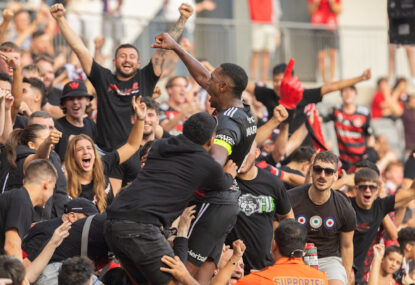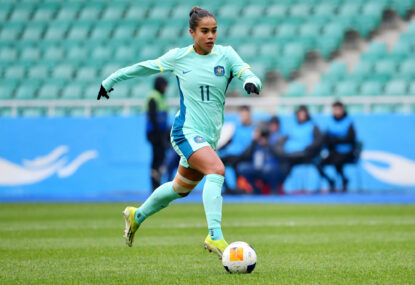The sight of kids standing, stagnate, while one of their peers performs an inane and meaningless drill with a coach is all too frequent in Australian sport.
Good willed parents and carers take up the enormous responsibility of mentoring young athletes and do their level best to foster enjoyment and success for their chargers. Football has never been immune to this.
Many of my early coaches were dads of fellow players, often enthusiastic migrants whose passion for the game was immense. Some were skilled players, yet few were aware of the finer details of skill development and the necessary drills and repetition required to ingrain good habits in young footballers.
Later in life, I felt I perpetuated the same failings. As much passion as I had for the teams I support, it didn’t automatically translate into the technical knowledge required to develop players to their full potential. No matter how much one loves football, it doesn’t parlay into successful coaching.
Throwing a few cones on the ground and asking kids to dribble around them will achieve something – probably the ability to dribble around cones – however, more intense, precise and meaningful strategies are required to see young players given their best chance to grow.
As the years have passed my drill armoury has increased, and as many coaching lessons have been learnt, I am now quite comfortable dealing with young players up to around 14 or 15 years of age. Beyond that, I will leave it to those working professionally in coaching programs on a full-time basis.
My club team is at under-14 level, female and an absolute treat to mentor. Having worked in education for many years, the opportunities to coach are myriad. In my current position, it has been a pleasure to step away from coaching and take on more of an administrative role, observing some seasoned pros mould the young footballers at their disposal.
The program is run at Barker College in Sydney’s north and overseen by Jonathon Sparks. After five years of his stewardship, the coaching and development program in which over 500 boys participate through the winter months has evolved enormously from what it was less than a decade ago.
In the past, many coaches, including me, performed their duties diligently and enthusiastically. The boys enjoyed their matches, yet training sessions were often simplistic and dull. A few basic drills followed by some crossing and shooting would generally lead to the remainder of the time being spent on a short internal game.
Sure, the students were kicking a ball, running and developing positive attributes such as teamwork, a healthy work ethic and an improvement in general fitness, yet the limitations were stark. Teams at the elite level of each age group were given excellent instruction and opportunity to develop, yet at the lower levels, the football program lacked significant polish.
In subsequent years, the evolution has been immense. Strolling across the playing fields from 7.00am on any given weekday presents a stark contrast to days gone by.
The most striking thing is what I like to call the ‘hum’ that emanates from the entire area. A concoction of that soft thumping sound of boot on ball, players calling out teammates’ names or a coach barking an instruction.
It’s somewhat loud yet at the same time eerily quiet, as if the concentration levels and intensity required to complete the drills creates something of a muted din.
As a football fan, it is a beautiful noise (sincere thanks to Neil Diamond). It permeates across the whole area, and when a morning fog lingers or cloud cover hovers above, it adds something even more romantic to the whole scene.
The photos I have taken of the field prior to the session starting view as something akin to an apocalyptic or moonscape setting. Hundreds of poles, cones and other equipment set up in such precise formations, with bags of footballs lying nearby, as the coaches gather to discuss their own matches and experiences in football from the week just passed.
Sparks has assembled an impressive array of staff to pass on their considerable knowledge and talents to the football hungry students. Former NSL player Robbie Hooker and ex-Socceroo Troy Halpin share their time between other coaching and managing commitments and the Barker program.
Coaching mentors, such as Elvis DeMarchi, oversee an age group, working with the team coaches and improving their performance. Coaches must be qualified at C level and many have B-level accreditation. Having elite A-level coaches in the program ensures that the instruction is of unquestionable quality.
Thirteen coaches are competing at an incredibly high level, with some representing NPL 2 clubs and others embedded in the under-20s system. Some of the mentors are ex-students who bring a unique perspective to the incredible development that has taken place in recent history.
The drills are precise and intense, with both individual skill levels addressed, as well as more team centred objectives such as defensive structures and formation.
Watching players take possession under pressure, turn and release a ball with speed and agility is a treat to watch. The coaches drive home key messages about balance, the use of both feet and control.
Each individual team within an age group has a specific formation. Long gone is the 4-3-3 come hell or high water. At the 16-year-old level, where my involvement lies, the Bs play a 4-2-1-3, whereas the Cs play a 4-1-2-3.
Seeing quality goalkeeper instruction where the basic skills of footwork, diving and decision making are taught by a qualified mentor is a far cry from the dark old days of shoving a kid with an ill-fitting fluoro shirt in goal for ten minutes while the rest of the team takes pot shots at them.
The science behind football has finally bled from the elite level all the way down to our grassroots and our players will be tangibly better off.
The college is an affluent school, well-resourced enough to implement such a program, and it would be foolish to think that these structures are standard across the nation. However, it is something of a model, and while far from perfect, has the potential to shape the planning of other clubs, schools and associations.
Football in this country has long struggled with the depth of quality in the coaching ranks, and while Barker College will seek to develop this further in the future, their structures and mechanisms are a significant step.
The teams against which they compete are doing similar things, and the increased level of participation among private school kids is being met with quality instruction.
I’m sure there is a variety of horror stories springing to mind as many readers reflect on their past experiences in coaching or administration of football clubs and teams.
Let’s hope that the new and improved professionalism that is becoming increasingly apparent continues and every one of our potential Socceroos or Matildas are given every chance to become just that.


































































































